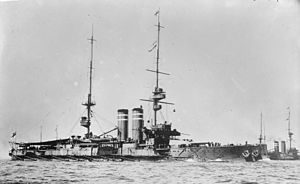King Edward VII-class battleship

HMS King Edward VII, lead ship of the King Edward VII class.
|
|
| Class overview | |
|---|---|
| Name: | King Edward VII class |
| Builders: | Chatham Dockyard, Devonport Dockyard, John Brown, Fairfield, Portsmouth Dockyard, Vickers |
| Operators: |
|
| Preceded by: | Duncan class |
| Succeeded by: | Swiftsure class |
| Built: | 1904–06 |
| In commission: | 1905–21 |
| Planned: | 8 |
| Completed: | 8 |
| Lost: | 2 |
| Retired: | 6 |
| General characteristics | |
| Type: | Pre-dreadnought battleship |
| Displacement: |
|
| Length: | 453 ft 6 in (138.23 m) |
| Beam: | 78 ft (23.8 m) |
| Draught: | 26 ft 9 in (8.15 m) |
| Installed power: | 18,000 hp (13,000 kW) |
| Propulsion: |
|
| Speed: | 18.5 kn (34.3 km/h; 21.3 mph) maximum |
| Range: | 5,270 nmi (9,760 km; 6,060 mi) at 10 kn (19 km/h; 12 mph) |
| Complement: | 777 |
| Armament: |
|
| Armour: | |
| Notes: | During their Grand Fleet service (1914–1916), the King Edward VII-class ships were nicknamed "The Wobbly Eight". |
The King Edward VII class was a class of pre-dreadnought battleships launched by the Royal Navy between 1903 and 1905. They were among the last pre-dreadnoughts built for the Royal Navy before the construction and launch of HMS Dreadnought in 1906, which immediately rendered them semi-obsolete.
By the outbreak of World War I in 1914, the King Edward VIIs had become so outmoded that they were used as minesweepers for the Grand Fleet's more valuable dreadnought battleships, though they also saw service in the Mediterranean and the Adriatic Seas, and two were deployed to support the naval assault on the Dardanelles. Two of the King Edward VIIs were sunk during the war, and the remainder were all placed into reserve by 1918, with the exception of HMS Commonwealth, which was refitted to serve as a gunnery training vessel. All surviving ships were sold for scrap in 1920–21. Alongside the Formidable class, they were the largest class of battleships built, with eight complete vessels.
By 1901, the 29 British battleships of the Majestic, Canopus, Formidable, London, Queen, and Duncan classes then in service or under construction, all following the same basic design by Sir William White, had come under criticism as being undergunned for their displacement.
All the King Edward VIIs had four 12-inch (305 mm) guns in two twin turrets and a secondary armament of twelve 6-inch (152 mm) guns on a displacement of 13,000 to 15,000 tons; questions were beginning to arise as to the usefulness of 6-inch guns in the face of improved armor in foreign battleships, and it was noted that foreign navies such as those of Italy and the United States had begun to arm their battleships with an intermediate battery of 8-inch (203 mm) guns. The King Edward VII class was built as a response, with the intention of halting the gap in firepower and maintaining the dominance of the Royal Navy.
...
Wikipedia
